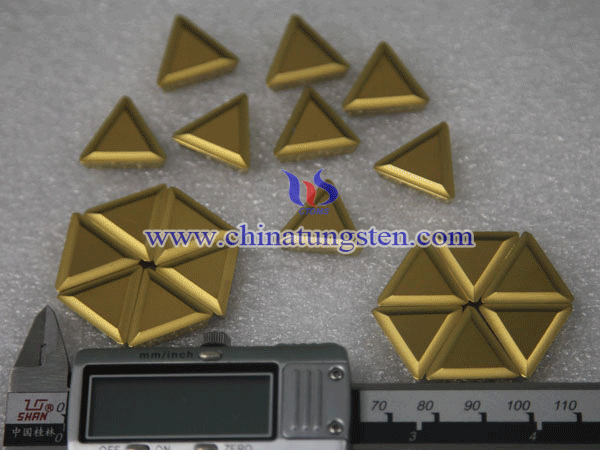Tungsten Carbide Inserts: Leaping Development of Manufacturing Field
- Details
- Category: Tungsten's News
- Published on Wednesday, 21 September 2016 11:09
Tungsten carbide is a very high hardness materials, cutting tools are mainly used in metal cutting has been widely used. In the machinery industry, mentioned alloy steel or tungsten carbide generally refers to such materials. Carbide cutting tools can be harvested many advantages. Compared to high speed steel cutting tools, in most cases, the use of carbide cutting tools can be harvested only workpiece surface quality is better, but also to obtain higher processing speeds; Carbide Tool can withstand higher cutting heat, which is that it can achieve a higher metal removal rate of the main reasons. When the workpiece machining high-alloy steel or stainless steel such easy processing, or in mass production and capacity expansion of the occasion, a case such as high-speed steel cutting tool wear easily and quickly, using conventional carbide tools can make cutting performance better.
Tungsten carbide cutting tools for metal cutting industrialization began in the nineteen thirties. Since then, it has evolved into carbide by far the most common tool materials. The relatively small size of carbide cutting tools are often made of a whole; only non-solid carbide cutting tools with carbide in the cutting area. Early non-carbide solid carbide tools tend to be welded to the cutter body. To the 1940s, carbide cutting tools manufacturers began producing holding interchangeable machine folder blade cutter, and benefit. Compared to the earlier welding tool, this brain-hole wide open to technological innovation and the use of mechanical clamping structure makes the tool more strength, which has now been recognized as a landmark invention, not only in the field of tool manufacturing further comprising bringing advanced and efficient process for the entire metalworking industry.
The considerable progress in the field of manufacturing opened up vast room for improvement, and immediately increase the carrying capacity of the tool, the tool has the ability to make rapid removal of metal. Replace the blade becomes more simple and cost reductions made to protect the economy, but also makes it possible to separately manufacture cutting module and the cutter body except for the blade failure due to wear or breakage failure. Replace the blades often need to consider the shape, quickly replace the failed cutting edge in several ways, in addition to the blade along the central axis indexing, there are also cases reversed blade front and back. Today, the most recognized industry wide dissemination of "indexable" the title, once also known as: the disposable tip, replaceable blade, replaceable blade.

tungsten carbide inserts photos
Tungsten carbide indexable insert production technology based on powder metallurgy technology, the production process is as follows: Preparation of carbide mixture, pressing, sintering, sintering treatment step and coating. Despite decades or more basic process remains the same, but at the same time from the progress of science and technology but then blade manufacturing had a significant impact.
Until the 1980s coated carbide grade has not yet appeared. At that time, such that carbide can be common to the processing of different engineering materials, tool manufacturers by adding different additives (such as a hard phase or a metal additive) to the preparation of different carbide grades. Coating technology adoption has greatly promoted the development of the global machinery industry; the vast majority of today are coated carbide grades. This new technology also brings additional benefits, so some special grades can be processed a certain class of materials to be processed. You do not need to add many kinds of cemented carbide substrate additives; This reduces the cemented carbide substrate grades, production process control more stable.
PVD coating in the late 1980s is introduced into the carbide production. PVD coating because at the nanoscale coating areas to overcome the manufacturing of many problems to achieve a breakthrough in the development. PVD coating thus providing a new level of higher wear resistance nano-coating. Compared to conventional PVD coating manner coating as shown by a maximum of 50 nm (nanometer) coating composite, it has been shown to greatly improve the binding strength of the coating.
Tungsten carbide blade production progress technologies from several areas of development. More cutting-edge technology of pressing, sintering technology, coating technology and post-coating technology, more diverse surface treatments can be carried out on the cutting edge of the blade more optimized manufacturing process together make indexable inserts can provide modern metal processing industry to provide more suitable to meet their needs efficient processing solutions.
| Tungsten Carbide Supplier: Chinatungsten Online tungsten-carbide.com.cn | Tel.: 86 592 5129696; Fax: 86 592 5129797;Email:sales@chinatungsten.com |
| Tungsten News&Tungsten Prices, 3G Version: http://3g.chinatungsten.com | Molybdenum News & Molybdenum Price: http://news.molybdenum.com.cn |



 sales@chinatungsten.com
sales@chinatungsten.com